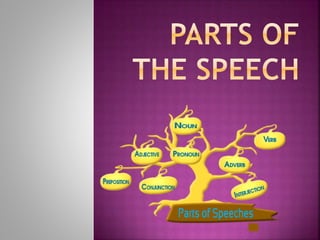
Understanding Parts of Speech
- 2. A noun is the name of a person, place, thing, or quality. Examples: PERSON: a girl, a driver, Kevin PLACE: a park, a city, Boston THING: tennis balls, milk, a Toyota QUALITY: friendship, joy, conficence What questions does a noun answer? Who or what.
- 3. Proper and common P: Princess Diana, Los Angeles, Friday, a Toyota C: a princess, a city, a day, a product Concrete (perceive with senses) and abstract (emotions, ideas, qualities) C: sunset, cars, cologne, doughnuts, breeze A: patience, childhood, justice, humor, success
- 4. Count and non countable C: assignment, fact, machine N-C: homework, information, machinery Identify the nouns in bold as CONCRETE, ABSTRACT, COUNTABLE, NON-COUNTABLE nouns. Write the answers on your notebook.
- 5. Verbs shows actions or being (existence). A verb is the heart of any English sentence. Examples: Action: run, eat, prepare, destroy, ask, love Being: be (am, is, are, was, were) What question does a verb answer? What does/did [subject] do? Verbs have four principal parts: base form, past, past principle, and present participle. Verbs can be regular and irregular.
- 6. Regular Their past and past participle forms use the suffix -ed. Examples: Work– worked Rob- robbed Flash- flashed Copy-copied Pull- pulled Seem-seemed Irregular They use a variety of forms, including suffixes –en, -ne as well as internal vowels changes or not. Examples: Take-took-taken Go-went-gone Sing- sang- sung Cut-cut-cut Fall-felt-fallen
- 7. Transitive They have an object for their action. (Who? and What?) Example: Love Kill Make Furnish (supply) Persuade Sense Put Hit I like the book I didn´t eat a big breakfast in the restaurant. Intransitive They NEVER have an object for their action. Not done by someone or something. They only involves a subject. Example: Die Arrive Occur Thrive (grow) Happen Travel Every single person voted. He dissapeared after the birthday party. The little girl sat quietly on the chair.
- 8. Some verbs can be transitive and intransitive. Read Move Study Watch Operate Run Agree Sit Examples: Mel walks for miles. Mel walks the dog for miles The apes played in the woods. The apes played hide and seek in the woods. Use your dictionary to know if verbs are tr. or intr.
- 9. Tell if the verbs are transitive or intransitive. Mention objects if the option is transitive.
- 10. Present tense verbs tell us what is happening now or talks about routines. Frogs croak loudly at night. Past tense verbs tell us what has already happened. The frog croaked loudly last night. Future tense verbs tell us what will or might happen. The frogs will croak loudly tomorrow night. Auxiliary verbs are helper verbs. That burglar alarm has been ringing for 10 minutes. I will call the police.
- 11. Auxiliary or helping verbs. Do How many cups of sugar does the recipe call for? Have The cost of living has been rising sharply. Modals You can do anything if you try. How will you get from the airport to lyour apartment? Shall we sit here for a while?
- 12. A pronoun is a word that can replace, or substitute for, a noun. Who? or What? Example: Oregon is on the western coast of the United States. It is in the Pacific Time Zone. They can be: Object pronouns (me, you, him, her, it, us, them) Relative pronouns (who, that, which, whom) Indefinite pronouns (anyone, anything, anybody, someone, something, somebody, no one, nobody) Reflexive pronouns (myself, yourself, himself, herself, itself, themselves, ourselves, yourselves) Demonstrative pronouns (this, that, these, those) Possessive pronouns(mine, yours, hers, his, its, theirs, ours) Reciprocal pronouns(each other, another)
- 13. Complete the sentences using the best pronoun. ________ want to eat now. (Daniel and Fabián) Can Marie see ________ , too? (Jack) Dr. Smith is a profesor ______ we like the most. The flight arrived late, _________ caused us many problems.
- 14. Adjectives describe nouns or pronouns. EXAMPLES: Good tallest slow problematic Green national expensive adorable What questions does an adjective answers? Which? The green book is mine. How many? There are six children in her family. How much? No one received any mail today. What kind? Raw milk can be dangerous.
- 15. More than one adjective to describe a noun have a special order: # one, ten, thousands Opininon fantastic, expensive, awful Size big, long, small Age elder, ancient, young Shape round, flat, square Color scarlet, purple, dark blue Origin Japanese, Colombian, German Material wooden, golden, plastic Purpose rocking, camping, sun Noun
- 21. An adverb is a word that modifies a verb, and adjective, or another adverb. They can be classified as: Manner: tells us how something is done or happens. Ex: slowly, quietly, badly, happily, well, hard, fast Place: tells us where something is done or happens. Ex: on the island, there, outside, below, under, upstairs Frequency: tells us how often something is done or happens. Ex: every day, often, rarely, twice Time: tells us when something is done or happens. Ex: before, now, fist, early, immediately, last month, soon, then, yesterday
- 22. Degree: tells us the level or extent that something is done or happens. Ex: almost, hardly, extremely, very
- 23. A conjunctoion is a word that connects parts of a sentence together. They are… linking words: I see a cat and a dog. Phrases: The cat might be on the bed or under the sofa. Clauses: The cat couldn´t walk because it had a broken leg.
- 24. Common conjunctions include: Coordinating: and, but, for, nor, or, so, yet Subordintating: after, although, before, because, even if, if, now, that, since, though, unless, until, when, while Correlative: both…, and…, either… or …, not only …but also…
